Hong Kong International Airport Conducts Largest-ever Integrated Drill to Test Typhoon Responses
2009/04/24
(HONG KONG, 24 April 2009)– Hong Kong International Airport (HKIA) today successfully completed its largest-ever integrated typhoon drill in a joint effort with the entire airport community. Over 600 staff from about 20 organisations and government departments took part in the exercise, testing responses related to various weather contingencies from flight rescheduling, flight information display and crowd management to baggage handling.
The multi-scenario exercise started at 0001 hours when the airport community was notified by the Hong Kong Observatory (HKO) of the approach of a strong typhoon. The Airport Authority (AA) immediately alerted airlines, the Civil Aviation Department (CAD), Hong Kong Police, ground handlers, ramp operators, cargo handlers, transport companies and retailers as well as caterers for emergency response, and also activated the Airport Emergency Centre (AEC) in skeleton mode. At the same time, the AA also deployed additional manpower and analysed flight situations. In addition, the AA and all relevant members of the airport community held coordination meetings to prepare for the typhoon.
As the weather worsened, typhoon signal number 8 was hoisted, and the HKO held another weather briefing at the AEC to detail the location, speed and direction of the typhoon as well as its possible impact on aircraft movements. In view of the rising number of affected flights and passengers, AEC swung into full operations at 0100 hours, serving as the control and coordination centre and communicating with the airport community to minimise operational disruptions. The CAD, AA, airlines and ground operators worked closely together as flight schedules continued to change due to inclement weather. More staff were also mobilised to handle the increasing amount of luggage at the Baggage Reclaim Hall.
In the terminals, passengers were updated on flight situation via the flight information display screens as well as other channels such as the airport website and mass media. The AA, Police, airport security staff, airlines and ground handling agents jointly managed the increasing number of passengers in the terminals. Designated areas were opened up to provide sufficient space for the large number of passengers lining up for check-in. Specific zones and additional signage were arranged for passengers at the airport's restricted areas.
"Contingency handling requires a high level of coordination among various members of the airport community, all of whom play different but equally important roles in their respective areas," said CK Ng, Deputy Director, Airport Operations, Airport Authority Hong Kong. "For example, the AA is responsible for coordinating with the airport community the rescheduling of aircraft movements as well as the resumption of orderly and efficient operation in the terminals and apron. We may also activate our Passenger Care Team to reach out to affected passengers by presenting bottled water, blankets and other assistance.
"The airlines, meanwhile, decide whether and when to cancel, postpone or divert flights according to the latest weather conditions and their own safety, operational and regulatory requirements. Upon making the decision to reschedule flights, the airlines will immediately update their passengers via multiple communication channels, including the airlines' website, enquiry hotlines and media. They will also inform the AA of any schedule changes so that we can make appropriate updates to our flight information display system. They will help passengers rebook flights to enable them to continue their journeys as quickly as possible, and they provide necessary amenities when appropriate," added Mr Ng.
The AA conducts more than 90 seminars, drills and exercises every year, 15 of which are related to weather disruptions. Through these initiatives, the airport community can test the readiness of its joint contingency plans and ensure that improvements in handling procedures and communications are made before the arrival of another typhoon season.
Today's exercise stood down at 0407 hours. It involved over 600 personnel from the following organisations, acting as participants or observers:
Airport Authority Government Departments - Airport Police Force - Civil Aviation Department - Hong Kong Observatory Business Partners - Aviation Security Co. Ltd (AVSECO) - Cathay Pacific Airways - Dragonair - HKIA Ferry Terminal Services Ltd - Hong Kong Air Cargo Terminals Limited (Hactl) - Hong Kong Airport Services Limited (HAS) - Jardine Air Terminal Services (JATS) - Jardine Airport Services Limited (JASL) - MTR Corporation - Singapore Airport Terminal Services Limited (SATS) - St. John Ambulance - Worldwide Flight Services (WFS)

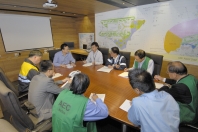
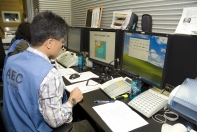 The Airport Emergency Centre (AEC) at the Hong Kong
International Airport is activated during the largest-ever
integrated typhoon drill to facilitate effective communication,
coordination and prompt actions among all airport communities
during contingency.
The Airport Emergency Centre (AEC) at the Hong Kong
International Airport is activated during the largest-ever
integrated typhoon drill to facilitate effective communication,
coordination and prompt actions among all airport communities
during contingency. 
 Weather experts from the Hong Kong Observatory
conduct a series of briefings to explain the location,
speed and direction of the typhoon, as well as
its possible impact on air traffic movements, helping
the airport community evaluate the situation more
accurately.
Weather experts from the Hong Kong Observatory
conduct a series of briefings to explain the location,
speed and direction of the typhoon, as well as
its possible impact on air traffic movements, helping
the airport community evaluate the situation more
accurately. 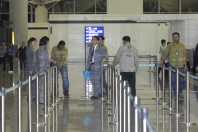

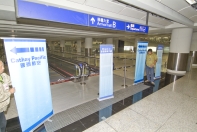
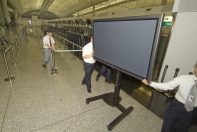
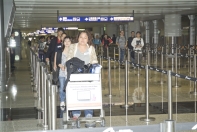 To better manage the increasing number of passengers
at the terminals, the Airport Authority, Police, airport
security staff, airlines and ground handling agents work
together to prepare designated areas for passengers
of different airlines to queue up for check-in. Additional
staff and signage are arranged to facilitate passenger flow
and maintain terminal order.
To better manage the increasing number of passengers
at the terminals, the Airport Authority, Police, airport
security staff, airlines and ground handling agents work
together to prepare designated areas for passengers
of different airlines to queue up for check-in. Additional
staff and signage are arranged to facilitate passenger flow
and maintain terminal order. 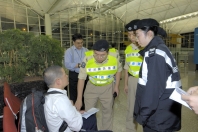
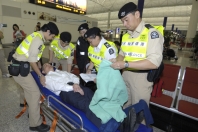 During the simulation, the St John Ambulance team and
airport staff take a passenger who suddenly feels unwell
to the nearby first-aid station for further treatment.
During the simulation, the St John Ambulance team and
airport staff take a passenger who suddenly feels unwell
to the nearby first-aid station for further treatment. 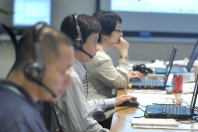
 When major traffic disruptions occur, Cathay Pacific
will activate its Integrated Operation Centre to closely
monitor passenger flow at the airport and coordinate
with the Airport Emergency Centre on flight rescheduling.
When major traffic disruptions occur, Cathay Pacific
will activate its Integrated Operation Centre to closely
monitor passenger flow at the airport and coordinate
with the Airport Emergency Centre on flight rescheduling. 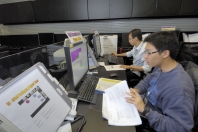
 Meanwhile, the AA coordinates with the Civil Aviation
Department and various airlines for flight rescheduling.
Upon reaching a decision to reschedule flights, the
airlines will update the public on the latest flight status
via their websites, enquiry hotlines and the media.
Meanwhile, the AA coordinates with the Civil Aviation
Department and various airlines for flight rescheduling.
Upon reaching a decision to reschedule flights, the
airlines will update the public on the latest flight status
via their websites, enquiry hotlines and the media. 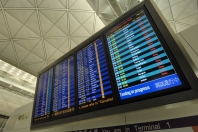 The Airport Authority updates its flight information display
screens throughout the terminals once it is informed by the
airlines of any schedule changes. The display screens also
tell passengers the latest weather conditions as well as
useful information like airline contact numbers.
The Airport Authority updates its flight information display
screens throughout the terminals once it is informed by the
airlines of any schedule changes. The display screens also
tell passengers the latest weather conditions as well as
useful information like airline contact numbers. 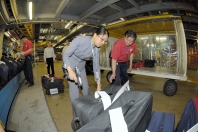
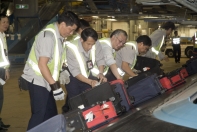
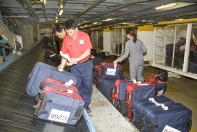 Affected by the inclement weather, a large number of
flights are either delayed or cancelled. To handle the
large volume of affected baggage, specific areas have
been allocated for the temporary holding of the baggage
to enable manual sorting by the ramp handlers for
subsequent loading onto respective flights.
Affected by the inclement weather, a large number of
flights are either delayed or cancelled. To handle the
large volume of affected baggage, specific areas have
been allocated for the temporary holding of the baggage
to enable manual sorting by the ramp handlers for
subsequent loading onto respective flights.  CK Ng, Deputy Director, Airport Operations, Airport
Authority, said today's exercise drilled HKIA's contingency
handling capability and roles of different members of the
airport community. The AA is responsible for coordinating
with the airport community the rescheduling of aircraft
movements as well as the resumption of orderly and
efficient operation in the terminals and apron.
CK Ng, Deputy Director, Airport Operations, Airport
Authority, said today's exercise drilled HKIA's contingency
handling capability and roles of different members of the
airport community. The AA is responsible for coordinating
with the airport community the rescheduling of aircraft
movements as well as the resumption of orderly and
efficient operation in the terminals and apron.
Download files
- Media Enquiry Hotline:
- +852 2188 7152
- Contact Email:
- media@hkairport.com
- Airport Authority Website:
- www.hongkongairport.com
- Customer Enquiry Hotline:
- +852 2181 8888

